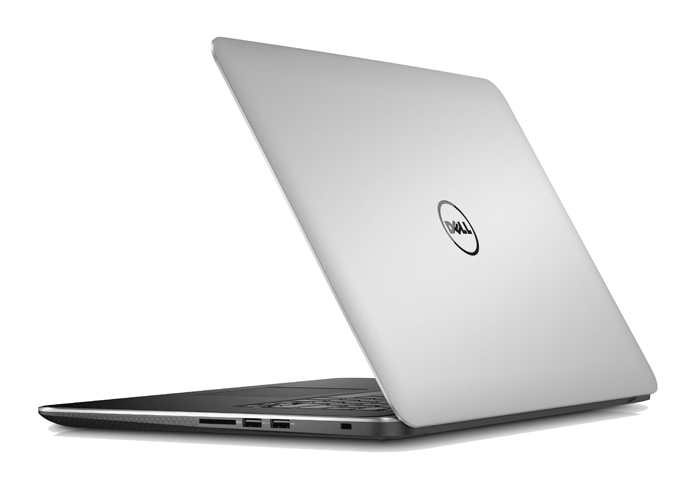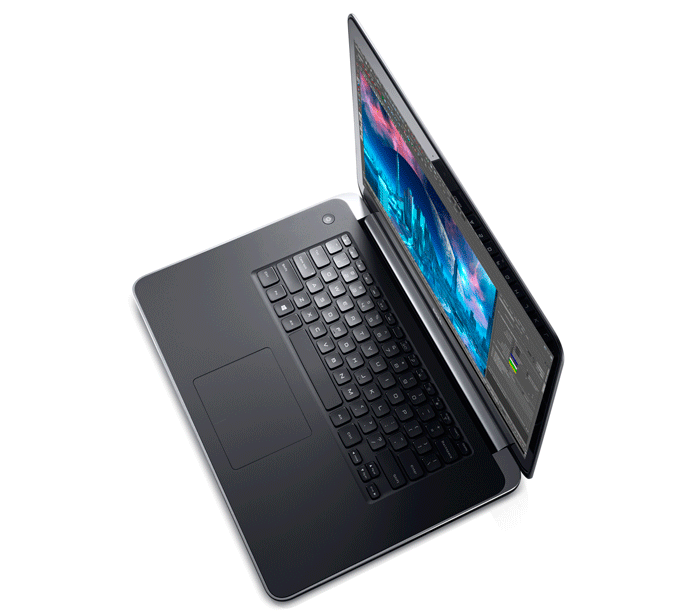Recently updated with a new 4K screen and Thunderbolt 2, Dell’s slimline beauty continues to shine, albeit with a few tradeoffs.
First unveiled in Autumn 2013, the Dell Precision M3800 was the original ultra portable 15-inch mobile workstation and, in our opinion, still the best looking. This slender MacBook Pro look-alike may lack originality but it is still a thing of beauty.
Beyond aesthetics, there is an innovative use of premium materials. A CNC machined aluminium lid protects the glorious 4K touch display, while a magnesium mid panel, overmoulded with silicone does a great job of keeping the palm rest surface cool to touch. The carbon fibre base gives lightweight strength as well as keeping laps at a comfortable temperature.
The insulation is important as the machine does produce a fair amount of heat, evident by its two audible fans, which kick into action during most CPU and GPU intensive operations. Warm air is expelled at the rear underside of the machine.
What the Precision M3800 lacks in acoustics, it makes up for in performance. With four CPU cores, the 37W Intel Core i7 4712HQ CPU cut through our 3ds Max rendering benchmark in a mere 300 seconds, twice as fast as the UltraBook-class HP ZBook 15u and Lenovo ThinkPad W550s, and not far behind the HP OMEN Pro or even the desktop Lenovo ThinkStation P500 reviewed earlier this year.

With a clock speed of 2.30GHz going up to 3.30GHz, a small improvement over the Intel Core i7 4702HQ CPU in last year’s model, it also performs well in single threaded applications.
For a machine of this size, 3D graphics performance is impressive and the 2GB Nvidia Quadro K1100M delivered solid scores in our CAD benchmarks. But there is a BIG caveat to this — and that is the impact of display resolution on 3D performance.
The new 4K (3,840 x 2,160) Dell UltraSharp touch panel is a thing of beauty. Vibrant colours certainly make the most of its pin sharp resolution and it is arguably the best laptop panel we have seen at AEC Magazine (even with its glossy finish that can be prone to annoying reflections in direct light).
But with four times as many pixels to push about on screen 3D performance can slow down. Running our SolidWorks benchmark at 4K (3,840 x 2,160) resulted in a significant drop in performance, less than half that we experienced at HD (1,920 x 1,080).
With PTC Creo the impact of resolution was negligible, so it is important to note that performance in relation to resolution will likely depend on the application, datasets and how the model is viewed (e.g. realistic effects or shaded).
The good news is, because HD uses exactly half the horizontal and vertical pixels as 4K, the image still looks good at 1,920 x 1,080 resolution. With other panels when you use a non-optimal resolution fonts and images will be blurry.
This is also an important consideration as software developers make changes to user interfaces. Many applications are still not optimised for 4K so icons and dialogues appear unreadable even with Windows settings ramped up. Having a real choice of HD or 4K in the Precison M3800 will help smooth the transition.
An HDMi and Mini DisplayPort are included to connect to external displays.
Storage is more standard, courtesy of a 256GB Solid State Drive Mini-Card (mSATA). While some may find this a little light on capacity, there are plenty of ways to remedy this — either by upgrading to a 512GB or (soon) 1TB mSATA, or adding a 2.5-inch drive (HDD up to 1TB, SSD up to 512GB or Solid State Hybrid Hard Drive (SSHD) up to 512GB).

User upgrades are possible but you will need a T5 Torx screwdriver to remove the 12 screws that secure the back panel. In addition to storage and memory, you will also find the 6-Cell battery which is rated at 91 WHr and not bad considering the spec of the machine. It lasted 2h 11min in our heavy duty PCMark battery test but we would expect much longer operation when using standard office applications.
The backlit island style keyboard and spacious trackpad with soft touch surround are a pleasure to use, but there is no numeric keypad.
For connectivity, the laptop is well appointed with three USB 3.0 ports and Thunderbolt 2 — a nice addition for those that want lightning fast external storage.
Intel Dual Band Wireless-AC 7260 means CAD data can be transferred over WiFi more quickly than with 802.11 a/b/g/n (providing you have an optimised network, of course). Gigabit Ethernet is still the preferred way to connect to the network but the slimline design means no Ethernet port. A USB to Ethernet adapter is included in the box though.

Other notable omissions include fingerprint scanner, smart card reader or dedicated docking port — all important enterprise features — although the machine can connect to a USB dock. Finding the balance between performance and portability is a major challenge for mobile workstation manufacturers. The emphasis on delivering performance in an exceedingly sleek chassis means inevitable trade offs in battery life and fan noise but the Precision M3800 continues to be an exceptional machine for CAD on the go, though be sure to consider the implications of having a 4K screen.
This review is part of a group test of Ultra portable 15-inch mobile workstations.
Below are links to the rest of the content
Those based on a business-class laptop chassis
Lenovo ThinkPad W550s
HP Zbook 15u
Those based on a 3D gaming laptop chassis
MSI WS60 mobile workstation
HP OMEN Pro
Specifications
» Intel Core i7-4712HQ (2.30GHz up to 3.30GHz) (4 cores, 8 thread)
» 16GB (2 x 8GB) 1600MHz DDR3L
» Nvidia Quadro K1100M (2GB) + Intel HD Graphics 4600
» 256GB Solid State Drive (SSD)Full Mini Card
» Display: 15.6” 4K Ultra HD (3,840 x 2,160) Dell UltraSharp, IGZO2, 10 finger multi-touch, wide view, LED-backlit
» Backlit full size keyboard. Gesture enabled multi-touch touchpad with two buttons » Battery: Dell 61 WHr 6-Cell Lithium-Ion Battery
» Keyboard / Mouse: Battery: Dell 61 WHr 6-Cell Lithium-Ion Battery
» Wireless: Intel Dual Band Wireless-AC 7260 @ 5GHz + Bluetooth 4.0 » Ports: 2 x USB 3.0 + 1 x USB 2.0 (all with PowerShare), Thunderbolt 2.0/mini DisplayPort (mDP). USB 3.0 to Ethernet adapter included
» Expansion / security: 3-in-1 media card reader » Display outputs: Mini DisplayPort, HDMi
» Docking: No dedicated docking port Dell D3100 USB 3.0 dock » Size (W x D x H) 372 x 254 x 8-18 mm » Webcam: Light sensitive HD video
» Weight (machine + power adapter incl UK plug): Starts at 1.88kg + 0.49kg
» Microsoft Windows 7 Professional 64-bit
» Standard 1-year (optional 3, 4 or 5 year) Next Business Day Service On Site Service after Remote Diagnosis
CPU benchmarks (secs – smaller is better)
CAM (Delcam PowerMill 2010) – (i) 190 (ii) 302 (iii) 426
CAE (SolidWorks 2010 Simulation) – N/A
Rendering (3ds Max Design 2011) – 300
Graphics benchmarks (bigger is better)
CAD (SolidWorks 2013 – SPECapc graphics composite) – 4.28 @ HD / 1.85 @ 4K
CAD (PTC Creo 2.0 – SPECapc graphics test) – 4.24 @ HD / 4.14 @ 4K
Battery test (PCMark 8) Compute intensive creative test (max & min brightness):2h 11mins 2h 42mins
External Storage
Mainstream 15-inch mobile workstations can typically hold up to three internal drives but their slimline siblings are limited to one or two. This increases the importance of external storage for storing huge CAD datasets.

To read our review of some of the most popular storage devices, click here.
If you enjoyed this article, subscribe to AEC Magazine for FREE






